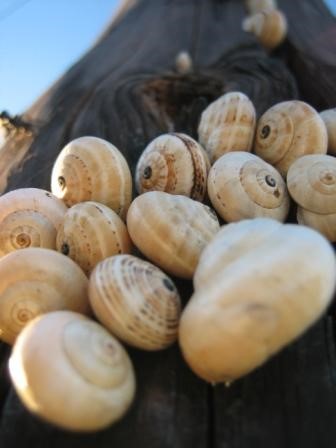-
These are either Cepaea hortensis or Cepaea nemroalis
snails. Both snails are found on the Greek Islands.
The mucous plug (epiphragm) serves to hold in fluids while the snail
hibernates. It also acts like a glue to connect them to structures.
They most likely climb up trees and other structures to escape enemies
while they are hibernating and I would imagine it is cooler as well.
Snails must do everything they can to keep in their precious fluids.
To dry out is to die! ...Avril B.
-
It is NO Cepaea surely. ...Lubosh
-
Surely it's not a Cepaea. Maybe Theba ¿pisana? as more
usual species, but also possibilities for Codringtoni a sp. or any
Hygromiidae. ...Javier
-
This is not a Cepaea, this is a Theba pisana. Best regards,
...Holger
-
It belongs to Helicellidae. This family contains several genera
which are extremely difficult to tell apart using shell-characters.
However the species in question is likely to be Trochoidea cretica
(Férussac 1822). It is likely that other helicellids have
been introduced there also.
Helicoids estivate during especially hot dry weather; they position
the aperture closely against a solid substrate and seal the gaps
up with mucus, which dries. Some members of the related family Helicidae
can survive for up to 5 years or so in this fashion. ...Andrew
-
They are 100 % Theba pisana to me. They are abundant
in south coast of Turkey also. ...ümit
-
I agree -Definitely looks like Theba pisana -Typical
habits and habitat.
Quite common here in southern Australia introduced along parts of
the coast. ...Geoff
-
Most probably the species is Theba pisana. The colour
pattern of Trochoidea cretica (belongs to the Hygromiidae!) is different.
Pisana is widespread in the whole mediterrenean area ...Wim
-
It also has tramped to the United States. According to Dundee
(1974: 31), it has not become established, but Pilsbry (1939: 13-14;
fig. 7) showed convincing evidence that it had become naturalized
in San Diego, Orange and Los Angeles Cos., California.
Dundee listed 19 countries of origin and ports in 19 different states
at which it had been intercepted!
I haven't seen or heard of it in Florida (yet).
It is named for Pisa, Italy, part of its natural range. ...Harry
...........
Dundee, D., S., 1974. Catalog of introduced mollusks of eastern
North America (north of Mexico). Sterkiana 55: 1-37. Sept.
-
Related to Harry's comments: Considerable effort was made to
eradicate this agricultural pest in California. To my knowledge,
it was all but eliminated except for small colonies here or there
(I know of one such colony in Santee, inland San Diego County where
it is found with Otala lactea, Helix aperta, Rumina decollata,
Cernuella virgata and Vallonia pulchella, all introduced). ...Phil
-
>Most probably the species is Theba pisana. The colourpattern
of Trochoidea cretica (belongs to the Hygromiidae!) is different.
Pisana is widespread in the whole mediterrenean area.
How DARE you people be right??
As I said, these beasties are difficult to identify.
According to Vaught and Abbott 1989 Trochoidea is in Helicellidae.
It might be of interest to some to hear that Candidula intersecta
is alive & well around limestone cliffs in New Zealand. They
can be extremely common after rain, even crawling across the bottoms
of very small pools, but when it's dry there will be not a sign
of any living specimen. ...--Andrew
-
Andrew - Candidula intersecta is also common here in
Melbourne in coastal areas and as you say is well hidden most of
the tome ...Geoff
-
I have found some in the Palos Verdes Peninsula area of Los
Angeles. ...Jack
-
First, Xerocrasa cretica (not Trochoidea anymore) is
a rather restricted invasive (Mediterranean only) and does show
so much polymorphism in the outside range (totally white or few
faint bands).
Second, rather correct way to put it was saying the pattern is totally
of pisana. Besides no Helicellinae (-dae) (Hygromiidae is
the correct term here) is globular in shape.
Candidula observation is interesting. But note that even
coastal, it is not a Mediterranean species but an Atlantic one.
Indeed, i doubt if they can survive summers Theba do and
if they get such long dry seasons. Like Cernuella and Cochlicellas
Theba is a dune dweller on the other hand...
Don't have an idea? Then ask Mediterranean snailers :) ...Ümit
:)
- Hi Simon, I observed exactly the same behavior that you described
in the S. of France in June, 2007. The snails were on most of the
grass stems, on weeds, on grape vines and they were always above ground
level and stuck tight. I identified them as Theba pisana which agrees
with the majority on Conch-L. They match your photo. Bert
